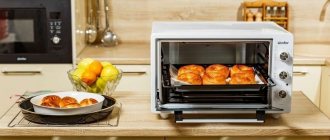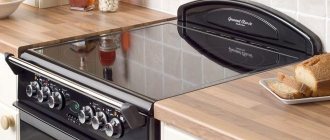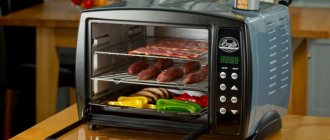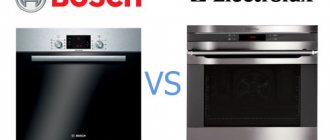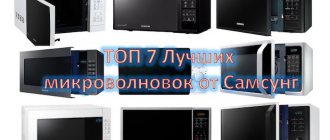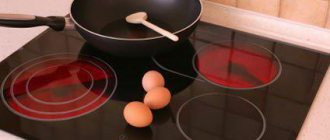There are a large number of kitchen appliances on the modern market, and the mini-oven is not the least important. This is an excellent solution for small spaces, cottages and the like. The choice must be made depending on the needs and functions of the equipment.
Microwave oven and mini-oven: what is common and what is the difference
Housewives have known the microwave for many years, but the mini-oven appeared on the household appliances market not so long ago. The mini-oven performs the functions of an oven, toaster, grill and microwave, as it is capable of defrosting food and heating food.
Similarities
The devices are similar in appearance. On the front side there is a glazed door and a control panel. They are compact and fit on the kitchen counter due to their small dimensions - within 30x50x40 cm. The size of the internal chamber is from 10 to 40 liters. The microwave and mini-oven (or electric oven is its second name) operate from the mains.
There is a similarity in electricity consumption: for a mini-oven it is 1.5-2 kV, for a microwave oven it is from 1 to 2 kV. These figures refer to devices with similar standard functionality and a price in the range of 5,000-10,000 rubles. As the chamber volume increases and additional functions are available, the energy consumption of the devices increases.
The type of furnace control can be mechanical or electronic. The advantage of a mechanical one is its simplicity and reliability, and an electronic one is an expanded choice of cooking methods.
The internal coating of the microwave and mini-oven chambers is made of enamel, stainless steel or ceramics. It is important that it can withstand high temperatures and is easy to clean.
Both devices are equipped with an internal chamber light, a tray for collecting crumbs and fat (in a microwave, this function is performed by a rotating plate), and a timer.
More expensive models of mini-ovens and microwaves have additional modes: convection, grill, spit. The energy consumption and price of such devices are significantly higher.
Differences
How is a microwave oven different from an electric oven? The main difference lies in the principle of operation. A mini-oven, like a traditional electric oven, cooks food using the heat generated by thermal heating elements - heating elements. The oven can reach temperatures from 30 to 250°C, baking the dish evenly.
A microwave oven cooks using ultra-high frequency (microwave) radiation, which is generated by a magnetron. Under the influence of microwaves, the water molecules present in any food begin to move, as a result of which the water boils, and the food in which it is contained rapidly heats up. Heating does not occur gradually and not from the outside in, as happens in a conventional oven, but throughout the entire product at once. In this case, the temperature does not rise above the boiling point - 100°C.
In most cases, a microwave oven is used to heat and defrost food. The main purpose of a mini-oven is cooking.
How to reheat food using a regular stove
Until 1947, the year the first microwave was released, people didn’t even think about how to reheat cold food. If you can cook food on the stove, why not heat it there too?
- pasta immediately before serving, since their main nutritional value lies in the full range of B vitamins, most of which are destroyed under prolonged exposure to high temperatures. However, if you still need to reheat it, transfer the pasta to a sieve and place in boiling water for 20 seconds.
- Pasta is a pasta dish with sauce. It can be heated in two ways: in a saucepan over low heat with the lid closed or in the oven for 15 minutes at 160°C, covering the baking sheet with food foil.
Or you can combine with the sauce only that part of the pasta that you intend to use immediately. Store the rest separately and combine before serving.
- the pizza in the oven, then the melted cheese will stretch like chewing gum. Place food foil on a baking sheet and heat it at 220°C for 10 minutes. Then place pizza slices on a hot baking sheet and bake for 8-10 minutes.
- mashed potatoes in advance. Its shelf life does not exceed 1.5 hours. But if you still have to, heat the pan on the stove, put the required amount of puree into it and add a little cream or milk. While heating, constantly mash the puree with a masher to prevent it from burning. Another way: simply transfer the puree into a pot and place in the oven at 160°C for 15 minutes, covered.
- Meat and fish dishes with a crust (grilled chicken, cutlets, meatballs) are heated in the oven. There is only one condition here - to retain moisture inside the product. To do this, wrap the product in food foil and place it in an oven preheated to 180°C for 10-25 minutes, depending on the thickness. If you want the crust to be crispy and crispy, do not cover the product with foil, but simply line a baking sheet with it.
- Dishes with sauce (meatballs, stews, beef stroganoff) are heated on the stove under the lid. If necessary, if the sauce has thickened too much, you can add a small amount of water.
- Boiled fish, poultry and meat are stored in the broth in which they were boiled. They warm it up in it. It is better to steam soft varieties of fish.
As you can see, there are quite a few ways to heat food. Choose the one you like, but don’t forget the most important thing:
Only freshly prepared food can be truly tasty and healthy!
The microwave oven is so firmly rooted in the everyday life of modern people that heating, and sometimes even cooking food in it has become quite commonplace.
According to average statistical data, only 1 out of 4 families manages in the kitchen without a microwave oven. And this is not surprising, because such a popular household appliance heats up food in a matter of seconds and without additional calories in the form of oil.
But what to do if the microwave breaks down or for some reason is out of reach? How to quickly reheat food and preserve all its original properties - from taste and smell to the content of nutrients?
Microwave Oven Features
The main advantage of a microwave is its speed. 1-2 minutes is enough to heat up the finished dish. The plate will remain cool, and if it warms up, it will only be due to the temperature of the food itself. In the microwave you can cook oatmeal, quickly bake vegetables, and prepare some other simple dishes. The porridge will be cooked in a deep bowl in 2-3 minutes, and the omelette will be baked in a plate in 5 minutes. Using a microwave reduces the time for cooking and heating food and, as a result, energy costs.
But this device also has a significant disadvantage. Cooking in a microwave oven occurs on the principle of internal heating and evaporation - this limits the possible range of dishes. In a budget microwave, the meat will not turn crispy, and you will also not be able to bake a pie.
More complex devices are designed for frying and baking - combination microwave ovens, equipped with additional functions.
Reference. The following manufacturers offer high-quality microwave ovens: Samsung, Gorenje, LG, Hotpoint-Ariston, Redmond, Daewoo, Supra, BBK.
Varieties
Based on the operating principle of microwave ovens, they can be divided into several groups:
- Microwave, operating due to microwave radiation. Most often used for defrosting and heating ready meals. These models are the most popular and enjoy the most consistent consumer demand.
- A microwave oven with grill is a combined device, additionally equipped with heat emitters (quartz lamps or tubular heating elements). Microwave with grill is aimed at a more complex menu. You can fry meat with a golden brown crust, fish, and French fries in it.
- Convection microwaves . In such ovens, streams of hot air, pumped using special fans, are directed at the dish being prepared. Circulation of hot air promotes uniform baking of the product. If in a simple microwave the temperature does not rise above 100°C, then in an oven with convection mode it can reach up to 250°C. Such a microwave oven can replace an oven. Models with a convection function are much more expensive than a conventional microwave, their dimensions are larger, and their energy consumption is significantly higher.
- Inverter microwave. Microwave of the latest generation. The peculiarity of this device is that the radiation from its magnetron is controlled electronically. In a conventional microwave, the magnetron operates with constant power; its periodic turning off and turning on leads to a harsh effect of the emitter on food and surges in electricity in the network. Inverter ovens are more economical, but what is more important is that in them microwaves have a gentler effect on the product being processed.
- Multifunctional microwave ovens. The most expensive microwaves with grill and convection have various built-in programs, for example, defrosting followed by cooking, remember frequently used recipes, and can be programmed to prepare dishes according to their own “branded” recipes. The price of such stoves is from 20,000 to 40,000 rubles.
Advantages
Advantages of a microwave oven:
- high speed of cooking and heating food;
- the ability to cook without adding oil and fat, which is important for adherents of a healthy diet;
- preservation of vitamins and microelements, since food is heated quickly and is limited to 100°C;
- absence of food odors, which is important when using a microwave, for example, in the office;
- the ability to heat food directly in the plate, which is convenient and saves effort and time on washing dishes;
- compact size and nice design, the ability to be built into kitchen furniture or mounted on a bracket, which is important in small spaces.
Flaws
Microwave radiation. There is no objective data proving that microwaves are harmful to human health. However, an increasing number of people are refusing to purchase this device in favor of more environmentally friendly devices. And some people simply don’t like the taste of dishes cooked in a microwave oven; they consider it “artificial.”
When using a microwave, the following precautions should be taken:
- Do not use metal utensils or utensils coated with metal.
- When using plastic utensils, you should be guided by the “microwave” marking or the three-wave icon.
- You cannot heat liquids in closed containers, boil eggs, and peeled vegetables and sausages must first be pierced.
- It is forbidden to turn on an empty microwave.
- You should heat the water with caution, because if it overheats, it can boil almost instantly even from careless movement.
Air fryer
A universal electrical appliance in which manufacturers have created a tandem of microwave waves, smokehouses, deep fryers and steamers. How does he work? It's simple: heated air processes the products using a fan. In a glass thicket you can place gratings in several levels. Depending on the functionality, an air fryer can cook dozens of different dishes and quickly heat up food.
Mystery MCO-1503
Power - 1300 W, volume - 12 liters. Equipped with a halogen heater and a removable lid.
- Mechanical control type.
- There is a timer for a maximum of 60 minutes.
- Custom temperature control.
Self-cleaning is also available. You can sterilize dishes and food in it. Price - from 1250 rubles.
Now you know not only how to heat food without a microwave, but also how to cook dishes no worse than in a microwave oven. Choose heating and cooking appliances that suit you from our review or follow our buying tips.
Features of the mini oven
In a mini-oven you can bake cakes, pies and cookies, bake meat and fish, and stew vegetables. That is, cook the same dishes as in a conventional oven, only faster and more economically.
The volume of a standard oven is 50-70 liters, power consumption ranges from 2.5-4 kW, and the heating time to 180°C is 10-15 minutes. To maintain the desired temperature during baking, a sufficient amount of energy is required. Everyday meals are usually small and disproportionate to the volume of the chamber. It turns out that most of the oven's energy is wasted irrationally.
Due to its small volume, a mini-oven can heat up faster and maintain a high temperature longer. For example, a stove with quartz heaters reaches a temperature of 200°C in 2-3 minutes.
The advantage of a mini oven is that its performance is comparable to a full-size oven, and its energy consumption is lower.
The larger the volume of the oven, the more power is required to heat it up. The most popular models are those with a power of 1000-1500 kW.
Reference. Mini-ovens from the following manufacturers are popular: Bork, Delonghi, Simfer, Kitfort, Rommelsbacher, Dex, Galaxy, Steba, Gemlux, GFgril Breakfast Bar.
Modes
In a mini-oven, food is cooked under the influence of heat emitted by heating elements located in the upper and lower parts of the chamber. In a number of models, heating elements are replaced with quartz lamps. Such ovens heat up to the desired temperature faster.
The standard operating mode involves top or bottom heating or simultaneous heating of two elements. Additional modes: cooking pizza, single-sided or double-sided toast, baking, reheating, quick heating, defrosting and others.
Some models are equipped with convection and grill functions. Most ovens have a spit, a metal pin on which vegetables or meat are placed.
Regardless of size, all mini-ovens operate the same way - bake and stew. The only difference is the number of servings. A compact electric oven can fully satisfy the needs of an average family of 3-5 people.
Advantages
A mini-oven can replace a whole range of kitchen appliances and has many advantages:
- small size - suitable for a small kitchen, cottage, rented apartment, dormitory;
- the small volume of the chamber heats up faster and retains heat longer compared to a stationary oven;
- traditional, natural way of cooking, in which everything is delicious;
- the ability to quickly heat up dishes with a crispy crust;
- ease of use;
- an impressive list of dishes to prepare;
- profitability - low price and lower energy consumption compared to an oven;
- possibility of cooking in almost any container: metal, ceramics, clay, silicone, fireproof glass.
Flaws
With all its undeniable advantages, a mini-oven is a smaller and simplified oven model. Its two main advantages - its small size and a full range of oven functions - led to the presence of some disadvantages.
The body of the electric furnace heats up, and you can get burned on the walls and glass.
The tempered glass of the door (single in budget models, double in more expensive ones) also heats up. For comparison, the door of a stationary oven has four layers of protective glass.
Attention! If there are small children in the house, you need to make sure that they do not approach or touch the appliance while the mini-oven is operating.
Can an electric oven be used as a microwave?
More and more people, fearing the negative effects of microwaves, are looking for a replacement microwave oven.
A mini-oven, like a microwave, can be used to heat and defrost food. Defrosting in an electric oven occurs almost naturally under the influence of low temperatures (30-40°C), as if the product was simply placed in a warm place.
When heating ready-made dishes in an electric oven, the product is evenly heated from below, above and on the sides. Overdrying of food, which is typical for heating in the microwave, is excluded. You can make a hot sandwich in minutes. It’s more difficult with liquids: you can’t heat up the soup and serve it on the table in the same bowl. You also won't be able to warm up a mug of cold milk without heating the pan.
Myths about the microwave. There is an opinion that microwaves can change the structure of water and food and turn beneficial substances into carcinogens. However, microwave energy is not enough to break chemical bonds. In addition, it is known that water (except for frozen water) does not have a constant structure.
